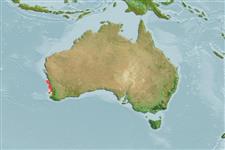Teleostei (teleosts) >
Perciformes/Serranoidei (Groupers) >
Anthiadidae (Fairy basslets or Streamer basses)
Etymology: Plectranthias: Greek, plektron = anyhting to strike with, spur + Greek, anthias = a fish, Sparus aurata (Ref. 45335); alleni: Named for Gerald R. Allen (Western Australian Museum)..
More on author: Randall.
Environment: milieu / climate zone / depth range / distribution range
Ecology
Marine; demersal; depth range 62 - 256 m (Ref. 8944). Subtropical; 29°S - 33°S (Ref. 123093)
Eastern Indian Ocean: Endemic to Western Australia.
Size / Weight / Age
Maturity: Lm ? range ? - ? cm
Max length : 7.1 cm SL male/unsexed; (Ref. 123579)
This species is distinguished from its congeners by the following set of characters: segmented dorsal rays 14 (rarely 13); pectoral rays 16 (rarely 15 or 17), middle rays branched; lateral line complete, 31-36 tubed scales; no antrorse spines on ventral margin of preopercle; no scales on maxilla; relatively distinct in having a short dark stripe in front of the eye, a faint dusky stripe from behind the eye across upper side of body, and a faint small dusky spot at midbase of caudal fin (stripes and spot better developed in small specimens) (Ref. 123579).
Found in the continental shelf (Ref. 7300).
Life cycle and mating behavior
Maturities | Reproduction | Spawnings | Egg(s) | Fecundities | Larvae
Paxton, J.R., D.F. Hoese, G.R. Allen and J.E. Hanley, 1989. Pisces. Petromyzontidae to Carangidae. Zoological Catalogue of Australia, Vol. 7. Australian Government Publishing Service, Canberra, 665 p. (Ref. 7300)
IUCN Red List Status (Ref. 130435)
Threat to humans
Harmless
Human uses
Tools
Special reports
Download XML
Internet sources
Estimates based on models
Preferred temperature (Ref.
123201): 15.7 - 20.4, mean 17.7 °C (based on 6 cells).
Phylogenetic diversity index (Ref.
82804): PD
50 = 0.5000 [Uniqueness, from 0.5 = low to 2.0 = high].
Bayesian length-weight: a=0.01000 (0.00244 - 0.04107), b=3.04 (2.81 - 3.27), in cm total length, based on all LWR estimates for this body shape (Ref.
93245).
Trophic level (Ref.
69278): 3.7 ±0.6 se; based on size and trophs of closest relatives
Resilience (Ref.
120179): High, minimum population doubling time less than 15 months (Preliminary K or Fecundity.).
Fishing Vulnerability (Ref.
59153): Low vulnerability (10 of 100).
